选修6 unit1 art new words and expressions
- 格式:doc
- 大小:71.50 KB
- 文档页数:3
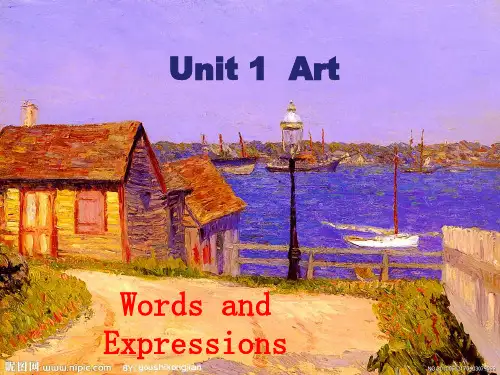
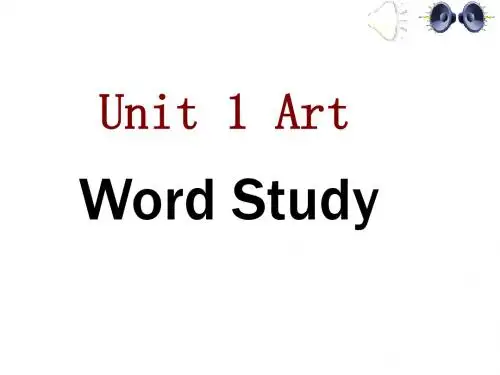
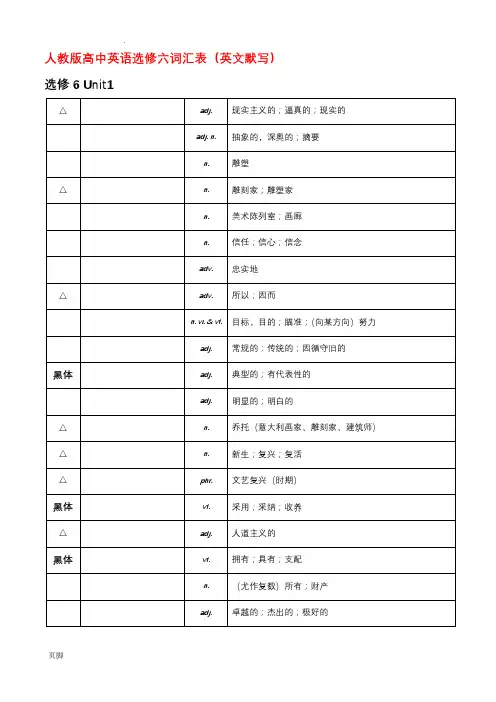
人教版高中英语选修六词汇表(英文默写)选修6 Unit1△adj. 现实主义的;逼真的;现实的adj. n. 抽象的,深奥的;摘要n. 雕塑△n. 雕刻家;雕塑家n. 美术陈列室;画廊n. 信任;信心;信念adv. 忠实地△adv. 所以;因而n. vi. & vt. 目标,目的;瞄准;(向某方向)努力adj. 常规的;传统的;因循守旧的黑体adj. 典型的;有代表性的adj. 明显的;明白的△n. 乔托(意大利画家、雕刻家、建筑师)△n. 新生;复兴;复活△phr. 文艺复兴(时期)黑体vt. 采用;采纳;收养△adj. 人道主义的黑体vt. 拥有;具有;支配n. (尤作复数)所有;财产adj. 卓越的;杰出的;极好的△n. 透视画法;透视图;观点n. 技术;方法;技能△n. 马萨乔(意大利画家)n. 巧合(的事);(事情、口味、故事等)相合phr. 巧合地△n. 杰作;名著△n. 印象主义;印象派△adj. n. 印象派的;印象派艺术家△adj. n. 后印象派的;后印象派艺术家黑体phr. 大量n. 阴影;影子adj. 荒谬的;可笑的adj. 争论的;争议的黑体n. vt. 努力、尝试、企图;尝试、企图黑体phr. (可是)另一方面黑体vt. 预言;预告;预测△n. 风景;景色黑体adj. 确切的;特定的n. 画像;身材;数字n. 黏土△n. 评论家;批评者△n. 青铜;青铜色;青铜制艺术品n. 大理石△n. 梦娜·丽莎(达·芬奇所作的一幅著名肖像画)△vt. 列奥纳多·达·芬奇(意大利著名画家)vt. 雕刻;刻记adj. 脆弱的;容易生病的;精致的米开朗琪罗(意大利文艺复兴雕刻家、画家、建筑师和诗△n.人)△n. 帆布;画布△n. 毕加索(西班牙画家)n. 咖啡馆;小餐馆adj. 过敏性的;对……过敏的△adv. 有效地n. 展览;陈列;展览会adj. 敢做敢为的;侵略的;好斗的n. 学者n. 肉;肌肉;肉体phr. 活着的;本人△n. 马蒂斯(法国画家)n. 几何学n. 束;串△n. 曼哈顿岛;曼哈顿区(纽约市中心)n. 林荫道;道路;大街n. 喜爱;偏爱△n. 古根海姆博物馆△vt. 展示;陈列;显露黑体vi. vt. n. 有感染力、呼吁、求助;将……上诉;呼吁、恳求黑体phr. (对某人)有吸引力;(使某人)感兴趣adj. 精细的;易碎的;脆弱的△adj. 圆形的;环形的;循环的△adj. 主要都市的;大城市的n. 名声;名誉n. 文明;文化;文明社会n. 埃及(东北非国家)adj. 埃及的;埃及人的adj. 视觉的;看得见的adj. 香的;令人愉快的△n. 莫奈(法国画家)△n. 惠特尼△n. 麦迪逊adj. 当代的;同时代的adj. 永久的;持久的n. 区;区域;行政区n. 委员会n. 署名;签字选修6 Unit2△n. 诗(总称);诗意vt. 给……标记号n. vi.& vt. 韵、押韵、押韵的词;(使)押韵vt. 传达;运送△n. 情感;情绪;感情n. 托儿所phr. 童谣黑体adj. 具体的△n. 重复;反复;循环adj. 引起矛盾的;好反驳的△vi.& vt. (使某人)安静下来△n. 嘲鸫(一种鸟,能模仿其他鸟的叫声)n. 钻石;菱形△n. 黄铜;黄铜器△n. 公山羊黑体adj. 灵活的;可弯曲的;柔顺的n. 模式;式样;图案△n. 乡绅n. 村舍;小屋△n. 棺材n. 麻雀△n. 小猫黑体phr. 轻松;不紧张;从容黑体phr. 用完△n. 五行诗黑体phr. 由……构成vi.& vt. 取消;招惹;戏弄adj. 含盐的;咸的△vi. 低垂;凋萎;萎靡△vi.& vt. 害怕;畏惧adj. 无穷的;无止境的△n. 俳句△n. 音节n. 最低限度;最少量;最小数n. 翻译;译文n. 枝条;支流;部门△vi. (melted;melted,molten)融化;溶化;软化△adj. 盈满的;满到边际的黑体phr. 尤其;特别黑体adv. 最后;终于△vt. 等候;期待黑体vi.& vt. 转化;装换;改造;变换△vi.& vt. (使)旋转△vt. 说;讲;发出(声音)n. 悲伤;悲痛;懊悔adj. n. 赤裸的、光秃的、稀少的;最基本的要素n. 图书馆馆长;图书馆管理员adv. 永远△n. 茎;干△n. 水泥n. 部分;节;切下的块黑体adj. 适当的;正当的黑体n. vi.& vt. 交换、交流、互换;调换、交换n. 毕业文凭;学位证书黑体n. vt. 赞助人、主办者、倡议者;发起、举办、倡议n. adj. 空白;空白的、茫然的n. 指南针;罗盘;(复数)圆规n. 新娘n. 新郎n. 冠军称号△adj. 有节奏的;有规律的n. 黑暗;漆黑n. 暖和;温暖黑体phr. 测试;试验n. 奖学金;学问;学术成就n. 钢琴家;钢琴演奏者n. 小提琴演奏者黑体phr. 发出;放走n. 负担;负荷物(尤指沉重的)选修6 Unit3n. 香烟;纸烟n. 酒;酒精adj. 酒精的黑体n.& vt. 滥用;虐待△n. 健康△adj. 性的;性别的黑体n. vt. 压力、重音;加压力于、使紧张△adj. 产生压力的;紧张的△n. (过度)肥胖;肥胖症n. adj. 青少年;青春期的n. 青春期黑体vt. n. 禁止、取缔;禁令、谴责黑体adj. 欠款的;预定的;到期的黑体phr. 由于……adj. 困难的;强硬的adj. 入了迷的;上了瘾的phr. 对……有瘾△n. 尼古丁vt. 使习惯于adj. 惯常的;习惯了的phr. 习惯于……n. 收回;撤退;戒毒(或脱瘾)过程△adj. 脾气暴躁的;易怒的黑体adj. 无意识的;自动的adv. 无意识地;自动地黑体adj. 精神的;智力的adv. 精神上;智力上vt. 停止(做某事);离开黑体n. 结果;效力n. 肺adj. 怀孕的adj. 畸形的;异常的adj. 气喘吁吁的;屏息的adj. 不健康的;不合适的;不合格的黑体vt. vi. 加强、巩固、使坚强;变强△n. 决心;决定黑体phr. 对……作出决定n. 小包;小盒黑体phr. 想要(做)……△n. 放松;松弛黑体adj. 绝望的;拼命的n. 药剂师;化学家△n. 树胶△phr. 口香糖黑体adj. 失望的;沮丧的△vi. vt. (对某事的决心)动摇、减弱;(使)变弱adj. 感到惭愧或羞耻的n. 理解(力)黑体phr. 不顾;不管黑体phr. 冒险黑体phr. 陷入;染上(坏习惯)adv. (et cetera) 诸如此类的事物;等等n. (复数-dixes,-dices) 附录;附件adj. 不合法的;违法的n. 药丸;药片△n. 抢劫;盗窃△adj. 滑的(Human Immunodeficiency Virus)人体免疫缺损病毒(艾滋病病△abbr.毒)(Acquired Immune Deficiency Syndrome)艾滋病(后天免疫缺损△abbr.综合征)黑体phr. 处境危险;遭受危险(Severe Acute Respiratory Syndrome)非典型性肺炎(严重急性△abbr.呼吸道综合征)△adj. 有免疫力的n. 幸存;幸存者n. 性;性别△n. 流体;液体△vt. 注射△n. 注射;注射剂n. 针;(注射器的)针头△vi. vt. (spilt, spilt) 溢出、洒落;使溢出、使洒落adj. n. 男性的、雄性的;男人、雄性的动(植)物adj. n. 女性的、雌性的;女人、雌性的动(植)物△n. 避孕套△n. adj. 同性恋;同性恋的n. 偏见;成见n. 看法;判决;判断△n. 迪斯科舞会;迪斯科舞厅n. 流产;中途失败n. 雪茄烟adj. 尴尬的;陷入困境的黑体adj. 局促不安的;笨拙的选修6 Unit4vt. 消费;消耗;耗尽;吃完△adj. 能再生的;可更新的△n. 温室;花房△adj. n. 华氏的;华氏温度计黑体phr. 发生;造成△n. 索菲(女子名)△n. 阿姆斯特朗(姓)n. 图表;坐标图;曲线图adj. 胡乱的;任意的n. (复数-ena) 现象vi. vt. 同意、捐赠、订阅;(签署)文件、捐助黑体phr. 同意;赞成;订购△n. 化石;从地下采掘出来的(矿物)n. 燃料△n. 副产品△n. 贾尼丝(女名)△n. 福斯特(姓或男名)△n. 甲烷;沼气△adj. (温度)摄氏的黑体n. 量;数量黑体phr. 大量的黑体vi. vt. 趋向、易于、照顾;照顾、护理黑体phr. 上升;增长;升起△n. 查尔斯·基林△n. 衡量;测量;尺寸prep. 每;每一n. 资料;数据黑体phr. 导致n. 趋势;倾向;走向n. 大灾难;浩劫n. 洪水;水灾△n. 旱灾;干旱△n. 饥荒△n. 乔治·汉布利黑体vt. 反对;反抗;与(某人)较量黑体adj. 反对的;对立的黑体phr. 反对……adj. 温和的;温柔的;淡的△adj. 环境的△n. 环境保护论者n. 结果;后果;影响黑体vt. 陈述;说明黑体n. 种类;范围黑体phr. 即使黑体phr. 继续黑体vi. n. 看一下、扫视;一瞥黑体adj. 平稳的;持续的;稳固的adv. 平稳地;持续地黑体n. 倾向;趋势黑体adj. 分布广的;普遍的黑体phr. 大体上;基本上△adj. 节约的;经济的△n. 公顷黑体adj. 平均的n. 生存;存在adj. 外部的;外面的黑体phr. 代表……一方;作为……的代言人△n. adj. 个人、个体;单独的、个别的vt. 拥护;提倡;主张n. 承诺;交托;信奉黑体phr. 忍受;容忍n. 污染;弄脏n. 增长;生长adj. 电的;与电有关的△n. 用具;工具;器具黑体phr. 只要adj. 随便的;漫不经心的;偶然的黑体phr. 等等n. 发动机n. 容器;罐头黑体n. 环境;情况n. 微波炉;微波vt. 使恢复;使振作n. 教育工作者;教育家n. 贡献△n. 祈使语气;命令△n. 标题△n. 标语;口号n. 显示;演出adj. 核的;核能的;原子核的n. 分歧;不一致选修6 Unit5n. 图解;图表;示意图n. 火山△adj. 火山的△n. 火山学△n. 火山学家vi. (指火山)爆发;突然发生n. 火山爆发;(战争等)爆发n. 灰;灰末△n. 火山口;弹坑△n. (火山喷出的)熔岩;火山岩n. 飓风;风暴n. 问卷;调查表黑体adv. prep. 在旁边、沿着边;在……旁边、沿着……的边n. 设备;装备黑体vt. 任命;委派△n. 观象台;天文台;气象台n. 数据库;资料库△n. 基拉韦厄火山vt. 评估;评价;估计phr. 全部焚毁黑体n. vi. 波浪、波涛;波动、起伏、挥手△adj. 熔化的;熔融的vi. & vt. n. 泉水般地喷出或涌出;喷泉、源泉黑体adj. 绝对的;完全的黑体adv. 绝对地;完全地△n. 宇航员;航天专家黑体n. vt. 一套外衣、套装;适合、使适宜n. 头盔n. 靴子黑体phr. 前往黑体n. adj. 潜在性、可能性、潜能;可能的、潜在的黑体adj. 实在的;实际的△n. 地质学△n. 埃特纳火山(意大利西西里岛东北部)△n. 西西里岛(意大利南部)△n. 样品;样本n. 候选人;候补者△n. 维苏威火山△n. 恐吓;威胁n. 平房;小屋△n. 庞培(意大利古都)△n. 龙卷风;旋风n. 台风n. 雷暴adj. 贵重的;珍贵的n. 小说家n. 雾n. 文件;证件n. 彩虹adj. 不舒服的;不舒适的n. 阳台adj. 失去知觉的;未察觉的黑体vt. (shot, shot)射中;射伤n. 射击;枪炮声vi. 摇晃;摇动;颤抖n. vi. 汗;出汗黑体adj. 忧虑的;不安的黑体n. 担心;焦虑;渴望黑体vi. & vt. n. (panicked, panicked)惊慌;惊慌、恐慌△n. 海啸;地震海啸黑体phr. 匆匆看一遍△adj. n. 满族的;满人黑体phr. 由……到……不等adj. 多种多样的;不同的△n. 多种多样;多样性△n. 鹤;吊车;起重机△n. 豹△adj. 引人入胜的;壮观的vi. 洗澡;游泳△vt. 激发;唤醒某人n. 欣赏;感激;感谢△n. 山顶;顶峰△n. 信服;说服黑体vt. 保证;担保。
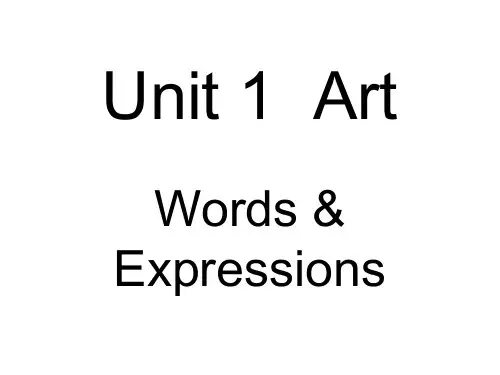
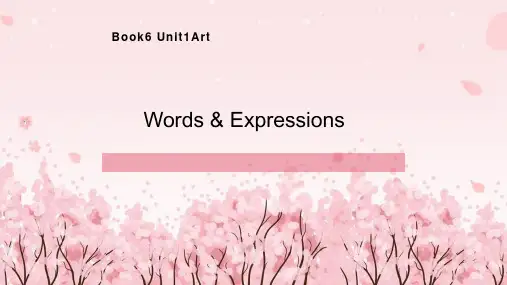
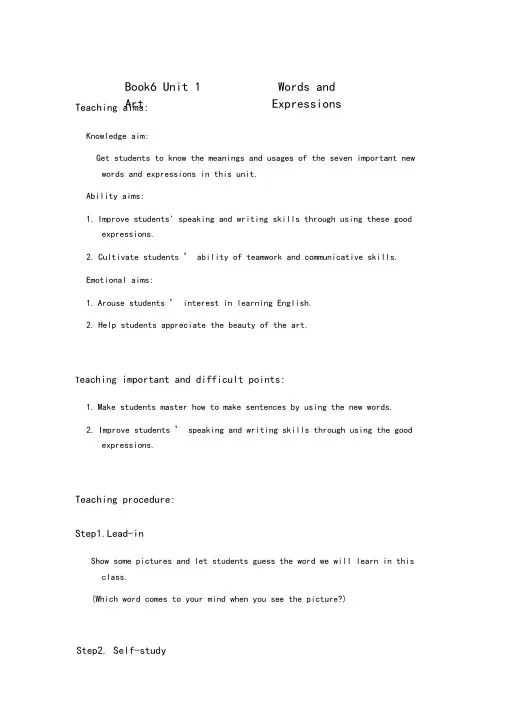
Step2. Self-studyTeaching aims:Knowledge aim: Get students to know the meanings and usages of the seven important newwords and expressions in this unit.Ability aims:1. Improve students' speaking and writing skills through using these goodexpressions.2. Cultivate students ’ ability of teamwork and communicative skills.Emotional aims:1. Arouse students ’ interest in learning English.2. Help students appreciate the beauty of the art.T eaching important and difficult points:1. Make students master how to make sentences by using the new words.2. Improve students ’ speaking and writing skills through using the goodexpressions.Teaching procedure:Step1.Lead-inShow some pictures and let students guess the word we will learn in thisclass.(Which word comes to your mind when you see the picture?)Book6 Unit 1 Art Words and ExpressionsDiscover the rules by yourselves , and then finish the related tasks.1. ---What is the angry bird aiming to do? ---It is taking aim at the pigs.2. To achieve his aim, some exercises are aimed at improving his sk 川s. Discovery:aim:v.①企图/力求做某事 ________________________________________②目的是;旨在 __________________________________________【即学即用】1. This advertisement (旨在)keeping people away from smoking.2. He (力求)be the best student in his class, and he works very hard in order to ( 达到 目 的).Sam was in possession of the car Bumblebee[?b? mbl](大黄蜂) and it was once in the possession of a worker.Discovery:Discovery 1|aimDiscovery 2possess v. 拥有;具有;支酉己一n. possession 所有财产(尤作复数)为•一所占有__________________________________占有,拥有________________________________Have a try: 用 in possession of / in the possession of 填空。
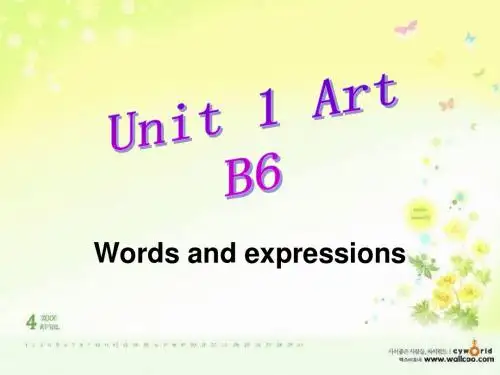
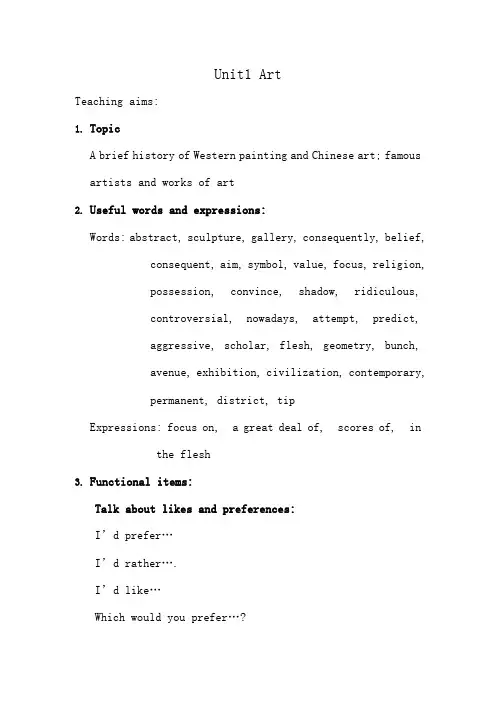
Unit1 ArtTeaching aims:1.TopicA brief history of Western painting and Chinese art; famousartists and works of arteful words and expressions:Words: abstract, sculpture, gallery, consequently, belief, consequent, aim, symbol, value, focus, religion,possession, convince, shadow, ridiculous,controversial, nowadays, attempt, predict,aggressive, scholar, flesh, geometry, bunch,avenue, exhibition, civilization, contemporary,permanent, district, tipExpressions: focus on, a great deal of, scores of, in the flesh3.Functional items:Talk about likes and preferences:I’d prefer…I’d rather….I’d like…Which would you prefer…?I really prefer….Would you rather…?Would you like…or…?4.GrammarThe subjunctive mood (1)If I were you…I wish I could/did/ would…If I did…. I would do….Teaching proceduresPeriod 1 ReadingStep 1. Warming upTask 1. Ask the Ss to match some new words with the correct English meanings.A Ba. realistic 1. accurate, minuteb. abstract 2. state or fact of existingc. existence 3. being in thought but having a physical orpractical existenced. detailed 4. lifelike, true tolifee. religious 5. classical, of old beliefsf. traditional 6. sincere to believe in a god or godsKey: a- 4 ; b-3; c-2; d-1; e-6; f-5Task 2: Ss look at the paintings in this unit and discuss the questions in Warming Up in groups of 4.Step 2. Pre-readingTask 3. Ss discuss and answer the following questions.1.Do you ever visit art galleries?2.What kind of paintings have you seen in galleries orin books?3.What are the names of some famous Western artists? Doyou know in which century they lived?Step 3. ReadingTask 4: Scanning : Ss read the passage quickly and find out the answers to the following questions.1.What were the artists interested in from 5th to 15thcentury AD?2.How did Masaccio paint his paintings?3.Why did the impressionists have to paint quickly? Task 5. Skimming: Ss read the passage again and complete the following chart.Step 4. After- readingTask 6: Ss read the passage again and deal with the Ex I and 2 in Comprehending.Period nguage learningStep 1. RevisionSs use the time line to retell the history of Western painting.The middle ages in Europe began form the e5 th century and lasted about 10 centuries. Paintings from this period are full of religious symbols. The following period is called the renaissance, which lasted almost 100 years. Masaccio discovered how to make paintings look more real by using perspective. This led to a great change in paintingstyles. Oil paints were developed which made colours look much richer. In the late 19 th, the impressionists developed a new style of painting. They were more interested in light and color. The impressionists’paintings are recognized as the beginning f modern art. Today there are many different styles of Western art and no doubt there will be even more new styles in the future.Step 2. SuffixationLet the students learn some uses of suffixes.1.Suffixes used as a noun signifier.2.Suffixes used as an adjective signifier3. Suffixes used as a verb signifierStep 3 PracticeSs finish Ex. 1 and 3 on page 42.Period 3. Grammar The subjunctive moodStep 1. Warm upWhat is the subjunctive mood?(it is used when we want to express a wish, request, recommendation or report of a command. It is also used to express something that is contrary to the fact, highlyunlikely or doubtful.)Step 2. PresentationThe structures of the subjunctive mood.1. Subject + wish + object clause2. “If” clause…, main clause….e.g.I wish I watched the basketball games.I wish I would fly freely in the sky.I wish I could buy a new computer.Step 3. PracticeGive the Ss some situations and ask them to discuss in groups of 4 by using the subjunctive mood.1.Helen has been living with AIDS for many years. Now sheis celebrating her birthday with her friends. If you wereHelen, what kind of wishes would you make?2.It is said that a falling star can let your dreams cometrue. If you saw a falling star, what kind of wishes would you make?3.Besides a falling star, a magic lamp can also let yourdreams come true. If you had a magic lamp, what would you ask it to do for you?Step 4. Practice1.Ss do Ex 2 on page 4.2.Ss finish Ex 1 and 3 on page 43.Period 4. Listening and speakingStep 1. ListeningTask 1: Do some listening practice on page 41.1.Ss listen to the tape for the first time to number thepresents 1-4.2.Ss listen to it again to fill in the form.3.Ss listen again and answer the questions in Ex 3.4.check the answer with the whole class.Task 2: Listening task on page 44.1.Ss look at the paintings and discuss in what period ofChinese history they were created.2.Ss listen to the tape and number the pictures.3.Ss listen again and write the names of the historicalperiods when they were painted.4.Ss list the features.Step 2. TalkingTask 3: S s in groups and discuss the questions on page 41. when they talk, try to use the following expressions.I’d prefer….I’d rather….I’d like…Which would you prefer…?I really prefer…?Would you rather…?Would you like… or… ?Period 5. Reading , Listening and WritingStep 1. ReadingTask 1: Ss read the passage about art galleries on page 5 and complete the following form.Task 2: Ss read again and complete the chart with the information from the passage.Step 2. ListeningTask 3: Gao Yan, Susan and John are on holiday. They are staying in a hotel in Manhattan, which is an island between two rivers in the centre of New York. Listen to the three friends discussing which art galleries to visit. Number the galleries in the order that you hear about them.Task 4: Ss listen again and answer the questions on page 7. Task 5: DiscussingWork in a small group. You have only one day to visit art galleries in New York. Read the tourist guide book again and tell your group which galleries you prefer and why. Decide together how you will spend the day. Use the following expressions:I’d prefer….I’d rather..I’d like…Which would you prefer…?Would you rather….?Would you like … or…?Step 3. WritingTask 6: Write a letter to the art gallery committee for starting a new art gallery in your district.1. Ss think about the following points:✧What kind of art works people in your district produceand would like to display;✧What kind of artworks people in your district might liketo learn about;✧Whether you would prefer to have local art in your gallery,art from all over China or art from all over the world;✧Whether you would prefer to have only modern art, onlytraditional art or both.2. Begin to write the letter.Period 6. Reading , speaking and writingStep 1. Reading task (page 45)Task 1:Fast reading: Ss read the letter on page 45 and answer the following questions.1.Why do they become worried?2.What do they hope the head master to do for their project? Task 2: Careful reading: Ss read again and make notes for a report abut the letter to the school council.Letter from ________________________________________________________ .Asking for ________________________ and _____________________________.Reason________________________________________________________ ____Their plan: 1.______________________________________________________ _2._______________________________________________________3._______________________________________________________.Work will be done by: ________________________________________________.Step 2. Speaking taskTask 3: Ss discuss how to improve the environment of their school in groups of 4. Ask some of them to speak out some proposals to make their school more attractive.Step 3. Writing taskTask 4: Ss write a letter to the headmaster of the school asking for permission to improve the environment of the school.Writing tips:➢Use the letter on page 45 as a model.➢Start the letter with your address, then the headmaster’s address and the date.➢Start your letter with an introductory paragraph that explains why you are writing the letter and gives a general idea of what you want to do.➢Describe your plan and how you will achieve it. Start a new paragraph for each new detail of your plan.➢End your letter with a summary of what you want the principal to do.。
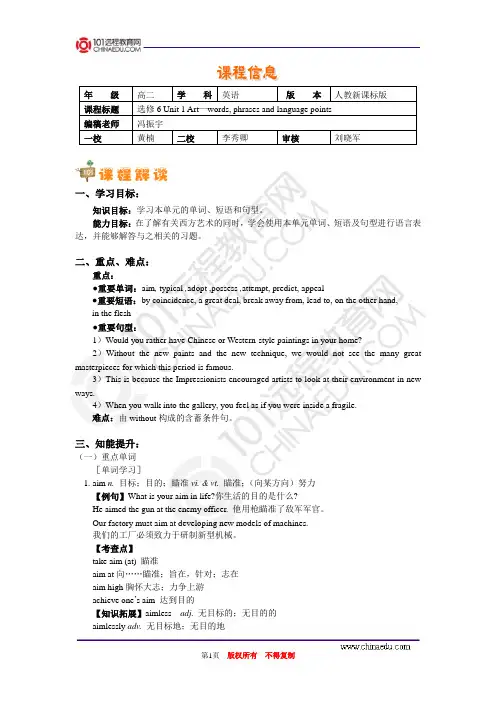
年级高二学科英语版本人教新课标版课程标题选修6 Unit 1 Art—words, phrases and language points编稿老师冯振宇一校黄楠二校李秀卿审核刘晓军一、学习目标:知识目标:学习本单元的单词、短语和句型。
能力目标:在了解有关西方艺术的同时,学会使用本单元单词、短语及句型进行语言表达,并能够解答与之相关的习题。
二、重点、难点:重点:●重要单词:aim, typical ,adopt ,possess ,attempt, predict, appeal●重要短语:by coincidence, a great deal, break away from, lead to, on the other hand,in the flesh●重要句型:1)Would you rather have Chinese or Western-style paintings in your home?2)Without the new paints and the new technique, we would not see the many great masterpieces for which this period is famous.3)This is because the Impressionists encouraged artists to look at their environment in new ways.4)When you walk into the gallery, you feel as if you were inside a fragile.难点:由without构成的含蓄条件句。
三、知能提升:(一)重点单词[单词学习]1. aim n. 目标;目的;瞄准vi. & vt. 瞄准;(向某方向)努力【例句】What is your aim in life?你生活的目的是什么?He aimed the gun at the enemy officer. 他用枪瞄准了敌军军官。
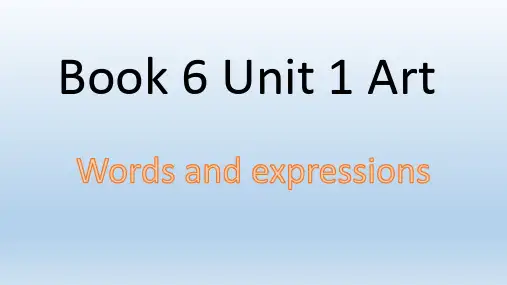
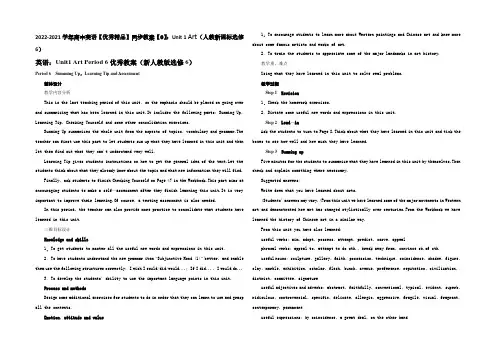
2022-2021学年高中英语【优秀精品】同步教案【6】:Unit 1 Art(人教新课标选修6)英语:Unit1 Art Period 6优秀教案(新人教版选修6)Period 6Summing Up,Learning Tip and Assessment整体设计教学内容分析This is the last teaching period of this unit,so the emphasis should be placed on going over and summarizing what has been learned in this unit.It includes the following parts:Summing Up,Learning Tip,Checking Yourself and some other consolidation exercises.Summing Up summarizes the whole unit from the aspects of topics,vocabulary and grammar.The teacher can first use this part to let students sum up what they have learned in this unit and then let them find out what they can't understand very well.Learning Tip gives students instructions on how to get the general idea of the text.Let the students think about what they already know about the topic and what new information they will find.Finally,ask students to finish Checking Yourself on Page 47 in the Workbook.This part aims at encouraging students to make a self-assessment after they finish learning this unit.It is very important to improve their learning.Of course,a testing assessment is also needed.In this period,the teacher can also provide more practice to consolidate what students have learned in this unit.三维目标设计Knowledge and skills1.To get students to master all the useful new words and expressions in this unit.2.To have students understand the new grammar item “Subjunctive Mood (1)” better,and enable them use the following structures correctly:I wish I could/did/would...;If I did...,I would do...3.To develop the students' ability to use the important language points in this unit.Process and methodsDesign some additional exercises for students to do in order that they can learn to use and grasp all the contents.Emotion,attitude and value1.To encourage students to learn more about Western paintings and Chinese art and know more about some famous artists and works of art.2.To train the students to appreciate some of the major landmarks in art history.教学重、难点Using what they have learned in this unit to solve real problems.教学过程Step 1Revision1.Check the homework exercises.2.Dictate some useful new words and expressions in this unit.Step 2Lead-inAsk the students to turn to Page 8.Think about what they have learned in this unit and tick the boxes to see how well and how much they have learned.Step 3Summing upFive minutes for the students to summarize what they have learned in this unit by themselves.Then check and explain something where necessary.Suggested answers:Write down what you have learned about arts.(Students' answers may vary.)From this unit we have learned some of the major movements in Western art and demonstrated how art has changed stylistically over centuries.From the Workbook we have learned the history of Chinese art in a similar way.From this unit you have also learned:useful verbs:aim,adopt,possess,attempt,predict,carve,appealphrasal verbs:appeal to,attempt to do sth.,break away from,convince sb.of sth.useful nouns:sculpture,gallery,faith,possession,technique,coincidence,shadow,figure,clay,marble,exhibition,scholar,flesh,bunch,avenue,preference,reputation,civilization,district,committee,signatureuseful adjectives and adverbs:abstract,faithfully,conventional,typical,evident,superb,ridiculous,controversial,specific,delicate,allergic,aggressive,fragile,visual,fragrant,contemporary,permanentuseful expressions:by coincidence,a great deal,on the other hand。
Unit 1 ArtVocabulary and Useful ExpressionsTeaching Goals:1. To enable Ss to master some new words and expressions2. To get Ss to have knowledge of this grammar point: the subjective moodTeaching Procedures:Step 1. Free talkIf you have a special chance to become a poet, what kind of poems will you write to people?And why?Step 2. Word studyPurpose: To consolidate the words and phrases in the text.1. Find a word in the poems that rhymes with each of the words below. Then add other words that rhyme. The first one has been done for you.(1) dead lead red thread fed said bed(2) high(3) sing(4) today(5) lace(6) trueSuggested Answers:(2) high sky pie my fly shy lie(3) sing ring wing thing king fling string(4) today away say play lay tray may(5) lace race face case chase place space(6) true too new flew few shoe canoe2. Complete the passage using the words below in the correct form.When I was a baby, my mother used to read me _________ rhymes, I loved their _______ and the way the words _________ at the end of the lines. By the time I was two years old, I could________ at least ten of them. When we _____________ new nursery rhymes, my mother would go to the store to buy another nursery rhyme book. In fact, my family loved reading so much that the living room in our __________ was full of books.Suggested Answers:nursery; rhythm; rhyme; recite; run out of; cottage.3. In English we sometimes add –ful to a noun to make an adjective. For example, wonder becomes wonderful. This means full of wonder. Now make adjectives form these nouns. Then add four other pairs you know.(1) beauty __________ (5) dread ____________ (9) __________ ____________(2) joy ____________ (6) hope ____________ (10) _________ _____________(3) sorrow _________ (7) peace ___________ (11) __________ ____________(4) delight __________ (8) power ___________ (12). __________ ____________ Suggested Answers:(1) beautiful (2) joyful (3) sorrowful (4) delightful (5) dreadful(6) hopeful (7) peaceful (8) powerful (9) thankful (10) successful (11) painful (12) useful4. Complete the table with the correct nouns, verbs, adjectives or adverbs.Suggested Answers:5. Complete each sentence using the correct word from the table you have just completed. (1) While you were reciting the poem, I think you moved your body very __________. It made the performance much more interesting.(2) Ad I lay in the _________, the words of a new poem came into my head.(3) The teacher doesn’t think that the _________ of the Tang poem is very good.(4) Songs are often easy to remember because they ________ a lot of poetry.(5) Your talk was so _________ that I want to go and write lots of poetry.(6) I loved the strong images you used in your poem to convey feelings of _________.(7) We were very __________ by the students’ performance of their poetry.(8) We passed the afternoon very _________ reading poetry together under the trees.(9) Mr. Tanner’s love of poetry has ________ the students’ feelings towards the subject.(10) Even though it is cold, your poem about summer has made me feel really ________. Answers:(1) expressively (2) darkness (3) translation (4) repeat (5) inspirational (6) anger (7) impressed (8) enjoyably (9) transformed (10) warmStep 3. Grammar1. PresentationPurpose: To revise the usage of the subjunctive mood with Ss.此表中需要注意几点:(1) be动词在表示与现在事实相反的从句中一般用were.在非正式情况先,第一、第三人称后偶尔也用was. 如:If he were you, he would go at once.(2) 主句中的should 通常用于第一人称,would,could以及might可以用于各种人称。
Book6 Unit 1 Art Words and Expressions Teaching aims:Knowledge aim:Get students to know the meanings and usages of the seven important new words and expressions in this unit.Ability aims:1. Improve students' speaking and writing skills through using these goodexpressions.2. Cultivate students’ ability of teamwork and communicative skills.Emotional aims:1. Arouse students’ interest in learning English.2. Help students appreciate the beauty of the art.T eaching important and difficult points:1. Make students master how to make sentences by using the new words.2. Improve students’ speaking and writing skills through using the goodexpressions.Teaching procedure:Step1.Lead-inShow some pictures and let students guess the word we will learn in this class.(Which word comes to your mind when you see the picture?)Step2. Self-studyDiscover the rules by yourselves ,and then finish the related tasks. Discovery 11. ---What is the angry bird aiming to do?---It is taking aim at the pigs.2. To achieve his aim, some exercises are aimed at improving his skills.【即学即用】1. This advertisement _________ (旨在) keeping people away from smoking.2. He ________ (力求) be the best student in his class, and he works very hard in order to _____________ (达到目的).Discovery 2 Sam was in possession of the car Bumblebee[ˈbʌmbl](大黄蜂)and it was once in the possession of a worker.Have a try: 用in possession of / in the possession of 填空。
人教版英语选修6课文原文及课文译文Unit 1 Art 第一单元艺术A SHORT HISTORY OF WESTERN PAINTING 西方绘画艺术简史The style s of Western art had changed many times, while Chinse art had changed less ofen.Art is influenced ['ɪnflʊəns]n. 影响;势力;感化;有影响的人或事vt. 影响;改变by the customs ['kʌstəmz]n. 海关;风俗(custom的复数);习惯;关税and faith [feɪθ+n. 信仰;信念;信任;忠实of a people. Styles [staɪlz]n. 风格;样式;模式(style的复数形式)in Western art have changed many times. As there are so many different style s of Western art, it would be impossible [ɪm'pɒsɪb(ə)l]adj. 不可能的;不可能存在的;难以忍受的;不真实的n. 不可能;不可能的事to describe all of them in such a short text [tekst]n. [计] 文本;课文;主题vt. 发短信. Consequently ['kɒnsɪkw(ə)ntlɪ]adv. 因此;结果;所以, this text will describe only the most important ones. Starting from the sixth century AD.chine [tʃaɪn] n. 脊骨;脊柱chinse [tʃins] n. 填隙;捻缝Chinese [,tʃai'ni:z] n. 中文,汉语;中国人adj. 中国的,中国人的;中国话的西方艺术风格变化较大而中国艺术风格变化较小。
高中英语 Unit 1 Art words andexpressions1导学案新人教版选修6Art words and expressions1导学案新人教版选修6【学习目标】1、To know the meanings and usages of the new words and phrases2、To use these words and phrases correctly in different situations、【学习内容】◆ 课前预习一、识记重点单词1、____________ n、信任,信心,信仰 ___________ adv2、____________ vt、瞄准 n、目标,目的3、____________ adj、典型的,有代表性的4、____________ adj、明显的;明白的5、____________ vt、采用;采纳;收养 _______________ n、6、____________ vt、拥有;具有;支配7、____________ adj、卓越的;杰出的;极好的8、____________ n、技术;方法;技能9、____________ n、巧合10、____________ n、阴影;影子11、____________ adj、荒谬的;可笑的12、____________ adj、争论的;争议的;13、____________ n、/v 努力;尝试;试图14、____________ vt、预言;预告;预测 ______________ n、二、巧记重点短语1、concentrate ____________ 把…、、集中于2、by ____________________ 巧合地3、____________________ 大量;许多4、_______________________另一方面5、_______________________ 宁愿,宁可6、_______________________ 挣脱,脱离课堂学习1、【原句重现】Art is influenced by the customs and faith of a people、faith n、信任,相信;信心,信仰【例句】I am delighted to know you have such faith in me、He is so strong-minded that he never loses faith in the future、After repeated failure, he lost faith in himself、【归纳总结】信赖,相信 ____________________________【即学即用】1)我的老板非常信任我。
高二年级英语adj. 真的adj. 现实主义的,逼真的n. 现实主义n. 现实主义者n. 现实,逼真adj. 抽象的;n. 摘要,概括adv. 抽象地,理论上n. 信任,信念,adj. 忠心的,忠诚的adj. 背弃信义的,不忠的adv. 忠实地,忠诚地adj. 典型的,有代表性的,特有的adv. 典型地adj . 明显的,显而易见的n. 明白,明显n. 证据v. 拥有,具有;支配,控制n. 所有,财产n. 结果,影响adj. 有效的,给人印象深刻的adv. 有效地n. 埃及adj. 埃及(人)的,埃及语的n. 埃及人/语1、abstract ________________________(1)美是抽象的,而房屋不是。
(2) The research shows that preschool children are capable of thinking in abstract terms.2、faith n. 信任,信念,信心have faith inlose faith in(1)我对她很有信心,她不会让我失望的。
(2)公众对政府的所作所为失去了信心。
3、consequently adv 所以,结果(相当于as a result )It rained that day and _____ , the baseball was called off .A. howeverB. stillC. consequentlyD. so4、aim n. 目标;目的;瞄准achieve one’s aimtake aim atwithout aimwith the aim of …He started to learn English with the aim of going abroad .aim v. 瞄准;目的是,旨在aim at (doing) sth.aim to do sth.(sth) be aimed at(1)他的目标是成为一个成功的作家。
He___________ be a successful writer .(2)他对准门射击,不料打中了窗子。
He _________the door but hit the window .(3)The project ______ helping young unemployed people .A. aims atB. is aimed atC. aims toD. for the purpose of(4)The workers worked day and night , _______ finishing the task on time .A. aimed atB. aiming to C .aiming at D. aimed to5、conventional adj. 常规的,传统的,因循守旧的break away from conventionconventional behavior /forces/weaponsShe is very conventional in her views .6、typical adj. 典型的,有代表性的,特有的咱们去一家典型的意大利咖啡馆吧。
be typical of sb. / sth.It is typical of sb. to do sth.(1)这幅画是他是期作品中典型的代表作。
This painting ____________ his early work.(2)他一向都是对此很生气。
It___________________ get angry about it .7、evident adj . 明白的,显而易见的It be evident (to sb. )that …她收藏了大量的唱片。
显然她是爱好音乐的。
She has a large collection of CDs. It ___________ to everyone that she loves music .8、adopt vt. 采纳;收养,n. adoption(1)Our school has ______ a new method to meet the requirement of the students .A. adaptedB. adoptedC. adjustedD. advanced(2) 他们决定收养一名地震灾区的孤儿。
9、possess v. 拥有,控制(1)他真的有些幽默感。
(2)A sense of fear _____ him as he walked into the house .A. hadB. ownedC. possessedD. possessionbe possessed ofbe possessed with / by(1)他极有自信。
He ___________________________ great self-confidence .(2)It was believed that people could be possessed by evil spirits.possessionin possession ofin the possession of sb /in sb.’s possessiontake possession ofcome into possession of(1)在火灾中他损失了所有的财产。
He lost all his ____________ in the fire.(2)他拥有这套房子。
He is _______________ the house .=The house is __________________ him .(3)父亲死后,她继承了一大笔财产。
On her father’s death , she __________a vast(巨额的)fortune .(4)直到三周后你才能拥有这所新房子。
You can’t ____________________ the new h ouse until three weeks later.10、coincidence n. 巧合(的事)It is a coincidence that…by coincidenceWhat a coincidence !(1)这真是奇怪的巧合。
(2)真巧,我没想到会在这儿见到你。
_________________I wasn’t expecting to see you here .(3)_____, my deskmate and I were born on the same day and same year , so we have a lot in common.A.By accidentB. By chanceC. By coincidenceD. By no means11、a great deal (of) 大量,许多(代替不可数名词;修饰不可数名词)(1) I have learned _____ from my visit here , so the city is well worth visiting.A. a great manyB. a great deal C . a great deal of D. a bit(2)他们的很多工作都是无报酬的。
_______________________ is unpaid .12、attemptattempt to do sth. / doing sth.他曾试图做这件事。
He attempted _____________ it .make an attempt to do sth.at the first / second attempt他试图成为一个优秀的学生。
He _______________ to become a good student .attempt / try to do sth.manage to do sth.他试图在公司得到一个高职位,但由于粗心而失败了。
He _______ to get a high position in the company ,but failed because of his carelessness.A. managedB. succeededC. attemptedD. thought13. predict vt. 预言;预告;预测n. prediction adj. predictable 可预言的It is predicted that …(1)很难预测将来会发生的事。
(2) 据预测一场暴风雨就要来了。
_________________ a storm will come .14. On(the) one hand …, on the other (hand)一方面…,另一方面…(for one thing … for another …)(1)He was praised by his teacher , but blamed by his friends _______.A. on the contraryB. on the other handC. on the bright handD. on the whole(2)我不想要这个;一是我不喜欢这种颜色,二是价格太高。
I don’t want this ;______________ ,I don’t like the colour , and ____________the price is too high .15、specific adj. 确切的;特定的adv. specifically 确切地;具体地;特别地to be specificbe specific to(1)我给过你明确的提示。
(2)具体地说,他已经34了。
______________, he is 34 years old .(3) 这种动物是这个地区特有的。
The animal ____________ this area .16、figure n.(1)By 2004, this figure had risen to 14 million.(2) He is a leading figure in the music industry.(3) I only saw a figure in black in the dim light.(4) I’m watching my figure. = I’m trying not to get f at.figure (sb. / sth ) outThe present situation is very complex ,so I think it will take me some time to figure out its reality17、delicate adj. 脆弱的;易碎的;微妙的;(1)China teacups are delicate .(2) The eye is one of the most delicate organs of the body.(3)她容易生病的孩子使她筋疲力尽。